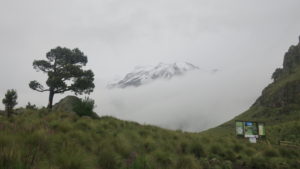 Mexico City has the best high mountain access in North America. Three volcanoes over 15,000’ lie within 50 miles of Mexico City: 1) Nevado de Toluca at 15,390 feet, 2) Iztaccihuatl (Ixta) at 17,159’, and 3) Popocatepetl (Popo) at 17,887 feet. Orizaba, the 3rd tallest peak in North America at 18,490’ is only ~100 miles away. Mexico City is accessible from the US with a four hour direct flight from SFO. During a recent Mexico City worktrip, I climbed Ixta to the mountaineering hut at 15,470 feet – higher than any NA peak outside Alaska – in one day.
Mexico City has the best high mountain access in North America. Three volcanoes over 15,000’ lie within 50 miles of Mexico City: 1) Nevado de Toluca at 15,390 feet, 2) Iztaccihuatl (Ixta) at 17,159’, and 3) Popocatepetl (Popo) at 17,887 feet. Orizaba, the 3rd tallest peak in North America at 18,490’ is only ~100 miles away. Mexico City is accessible from the US with a four hour direct flight from SFO. During a recent Mexico City worktrip, I climbed Ixta to the mountaineering hut at 15,470 feet – higher than any NA peak outside Alaska – in one day.
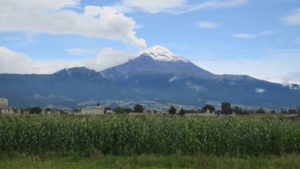 My destination, Ixta-Popo National Park, protects both Popo & Ixta. No climbers have summitted Popo since 1994 when volcanic activity closed the fifth tallest mountain in NA. Smoke plumes consistently rise above the summit. My destination, Itxa, is the the seventh tallest NA peak. According to Aztec lore, Ixta’s profile resembles a sleeping woman. The feet, knees, stomach, chest, and face form high points on Ixta’s long ride. The standard Arista del Sol route starts below the feet at 13,040 feet at the La Hoya trailhead. The route’s crux is the knees above the hut. The remaining glaciers are on the stomach, and the summit is on the chest.
My destination, Ixta-Popo National Park, protects both Popo & Ixta. No climbers have summitted Popo since 1994 when volcanic activity closed the fifth tallest mountain in NA. Smoke plumes consistently rise above the summit. My destination, Itxa, is the the seventh tallest NA peak. According to Aztec lore, Ixta’s profile resembles a sleeping woman. The feet, knees, stomach, chest, and face form high points on Ixta’s long ride. The standard Arista del Sol route starts below the feet at 13,040 feet at the La Hoya trailhead. The route’s crux is the knees above the hut. The remaining glaciers are on the stomach, and the summit is on the chest.
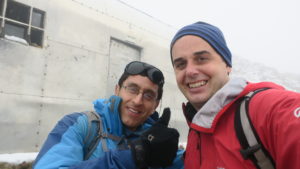 With only one day available, I used the Servimont guide service to drive directly from the airport and guide me on the mountain. Previously, I used Servimont on a Nevado de Toluca climb. Most US climbers visit from Nov to Jan during the dry season, but the summer months are an excellent time for a rapid ascent. I could not have climbed the peak with Servimont due to low visibility, changing weather, and multiple paths. The remnants of a hurricane made for some challenging weather on the peak. The weather would not clear until we descended back to the van.
With only one day available, I used the Servimont guide service to drive directly from the airport and guide me on the mountain. Previously, I used Servimont on a Nevado de Toluca climb. Most US climbers visit from Nov to Jan during the dry season, but the summer months are an excellent time for a rapid ascent. I could not have climbed the peak with Servimont due to low visibility, changing weather, and multiple paths. The remnants of a hurricane made for some challenging weather on the peak. The weather would not clear until we descended back to the van.
Carlos, my guide, and Rogelio, my driver, met me at the Mexico City Airport after a redeye from San Francisco. I went from sea level to over 15k feet in a few hours – which is not recommended. However, I’ve acclimatized well in the past, took Diamox, and drank plenty of water. We drove to Ixta- Popo Park and arrived at Paso de Robles – the pass where Cortez passed on his conquest on the Incas.
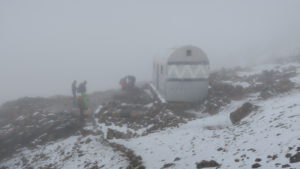 After eating some freshly prepared food, we started walking at 9:30 am. We passed through grasslands to sand, rocks, and snow. The mountain was relatively empty of climbers. We only saw only 8 other climbers during the day. On our way to Los Cien Hut, we passed four landmark portillos (rock formations). The climbing was straightforward class 2, but route finding was a challenging in the fog. My challenge was the altitude, and I had to stop periodically to catch my breath. Toward the hut, the trail flattened a bit, and the ghostly outline of the hut emerged. It felt good to reach my goal although the hut had seen better days. We took some photos, ate a little food, and descended. Hearing nearby thunder encouraged a rapid descent. My challenge on the return shifted from tired lungs to tired quads.
After eating some freshly prepared food, we started walking at 9:30 am. We passed through grasslands to sand, rocks, and snow. The mountain was relatively empty of climbers. We only saw only 8 other climbers during the day. On our way to Los Cien Hut, we passed four landmark portillos (rock formations). The climbing was straightforward class 2, but route finding was a challenging in the fog. My challenge was the altitude, and I had to stop periodically to catch my breath. Toward the hut, the trail flattened a bit, and the ghostly outline of the hut emerged. It felt good to reach my goal although the hut had seen better days. We took some photos, ate a little food, and descended. Hearing nearby thunder encouraged a rapid descent. My challenge on the return shifted from tired lungs to tired quads.
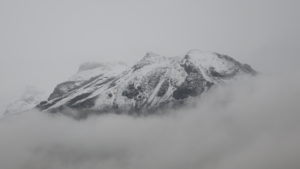 At the La Hoya trailhead, we celebrated with excellent sandwiches and hot drinks. During the entire climb, visibility was limited. We could not see the upper mountain. At the parking lot, Ixta briefly showed herself, and the weather was cleared around Popo. I returned to my hotel in Mexico City, ate a bit, and slept soundly until the next day.
At the La Hoya trailhead, we celebrated with excellent sandwiches and hot drinks. During the entire climb, visibility was limited. We could not see the upper mountain. At the parking lot, Ixta briefly showed herself, and the weather was cleared around Popo. I returned to my hotel in Mexico City, ate a bit, and slept soundly until the next day.
I highly recommend climbing the Mexican Volcanoes. They are beautiful, accessible, and high. Mexican guide services like Servimont help maximize the chances of an outstanding time, especially if time is limited.
